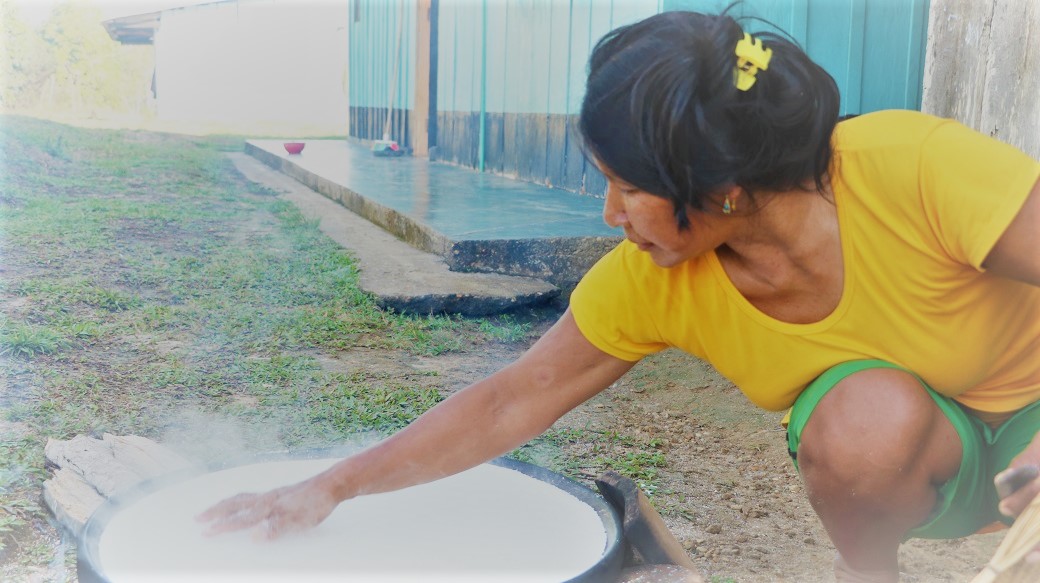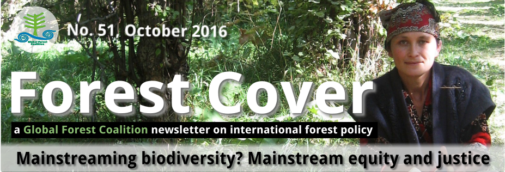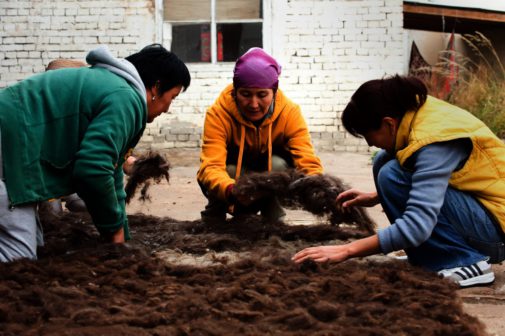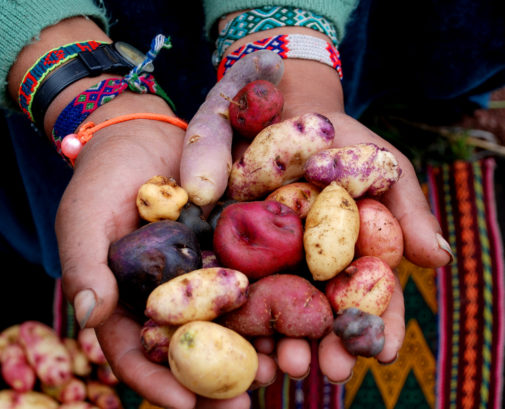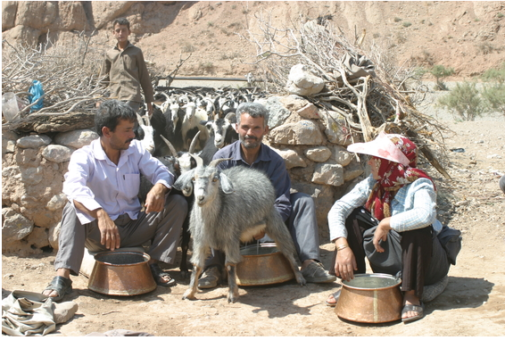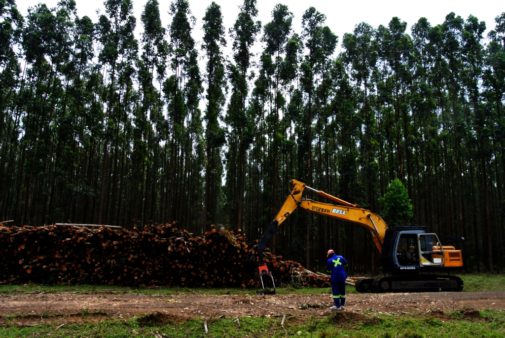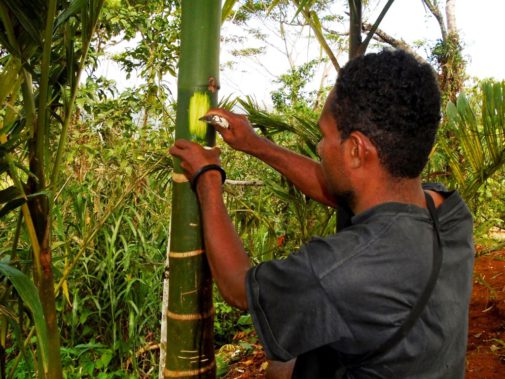Forest Cover 51 – Mainstreaming biodiversity? Mainstream equity and justice
Welcome to Forest Cover No. 51, the Global Forest Coalition newsletter that provides a space for Southern and Northern environmental justice activists to present their views on international forest-related policies.
In this 51st edition of Forest Cover we examine the importance of incorporating a gender perspective in biodiversity conservation and the launching of the ‘Women2030’ global programme with case studies from Kyrgyzstan. We take an in depth look at what “mainstreaming biodiversity” means, the opportunities and challenges of the upcoming CBD COP13 taking place in Cancún, Mexico from December 4th-17th, the dangers of corporate driven climate interests, and the significance of including Indigenous Peoples, traditional knowledge, peasants, and women in biodiversity conservation.
Finally we highlight the threats monoculture tree plantations and market-based approaches to climate change pose to biodiversity conservation, and, demonstrate the need for an inclusive and sustainable approach through data from the Community Conservation Resilience Initiative.
You can download the print version or read the articles individually below. To subscribe to the newsletter, please write to gfc@globalforestcoalition.org
Download the print version (web quality) or (low resolution PDF)
Contents
Preface: Natural Ecosystems and Biodiversity Loss: a Gender Perspective
Feature: Mainstreaming biodiversity in agriculture – a threat to food provision by communities?
Feature: Climate Finance: dark days for the world’s forests
Feature: Biodiversity and poverty: steering clear of The Midas Touch
Natural Ecosystems and Biodiversity Loss: a Gender Perspective
By Anna Kirilenko, Ecological Movement BIOM, Kyrgyztan
Damage to natural ecosystems and biodiversity loss is not gender neutral. Women and men perceive, are affected by and respond to the consequences of biodiversity loss differently; and they impact biodiversity in different ways as well. These differences are related to the fact that men and women have distinct roles and responsibilities in relation to biodiversity and differing access to natural resources. They also have different levels of influence with respect to related decision-making processes. A further complication is that biodiversity loss also impacts women and men in different social strata in different ways.
Thus, like poverty, gender is an essential dimension of biodiversity loss that cannot be ignored. In fact the two aspects are interrelated, creating mutually reinforcing barriers that prevent social and environmental change if they are not addressed. All in all it is critical that both poverty and gender are fully recognised in global and national policies designed to implement biodiversity programmes and strategies if they are to be effective.
This recognition is urgent. The degradation of natural ecosystems and biodiversity loss is one of several unprecedented, large-scale environmental crises unfolding around the world, including in Central Asia. The severity of this crisis is reflected in the United Nations (UN) Sustainable Development Goals (SDGs) 14 and 15 (on marine and land-based biodiversity), [1] and the Convention on Biological Diversity (CBD)’s Strategic Plan for Biodiversity 2011-2020 and Aichi Biodiversity Targets.[2]
As natural (wild) ecological systems, forests fulfill ecosystem functions relating to the regulation of the climate, the formation and recovery of soils, and disaster risk reduction. They are essential to the maintenance of the conditions necessary for the existence of life. This means that addressing the problem is complex [3] but unavoidable if the planet is to remain habitable.
In light of the need for gender-responsive policies to protect biodiversity specifically and promote sustainable development in general, Global Forest Coalition (GFC), together with a number of other organisations, has launched the ‘Women2030’ global programme. Women2030 is focused on the empowerment of women in sustainable development and on the need for gender-responsive implementation of the SDGs, including SDG 15 on forests and biodiversity.
Women in Kyrgyzstan process raw wool. UN Women/Flickr
For example, in Kyrgyzstan, through consultations with local communities it was found that local women play a key role in retaining traditional crop varieties and following the traditional practice of using agro-forestry production systems such as the cultivation of fruits and vegetables in homestead lands, and the collection and sale of foods such as nuts, mushrooms and apples, within small businesses. In addition they are mainly charged with the collection of firewood for the household, and plants for food or for the production of medicines.
In participating communities in southern Kyrgyzstan, households also have a tradition celebrating the birth of a child by planting 12 popular trees that grow with the child and can then be used by the child to build their house later in life, when they have grown. The mothers generally care for the seedlings. After exchanging information about their practices, women from northern communities have now taken the initiative to introduce this tradition in their own communities.
Consultations also revealed that men tend to be engaged in higher income-generation activities, such as the procurement and processing of wood. For example, studies conducted in Kyrgyzstan identified that compared to men, women have less access to natural resources except for non-timber forest products, which are mainly collected by women.
In Kyrgyzstan the Women2030 programme together with local organisation BIOM will be supporting the development of women-led initiatives in the participating communities supporting the collection of medicinal herbs, the restoration of pastures and soil fertility, and breeding birds to reduce the load on local ecosystems and contribute to the fight against poverty.
Recognising and addressing these gender differences should also underpin the development of national biodiversity and forest management strategies, policies and programmes—this is particularly relevant for the upcoming Thirteenth Meeting of the Conference of Parties to the Convention on Biological Diversity (CBD COP 13) in Cancun, Mexico, 4-17 December 2016.
GFC and member groups from over 17 countries that are involved in the Women2030 programme will participate in CBD COP 13, including through the women’s caucus. They intend to present findings from the programme and to advocate for the meaningful participation of women, including indigenous and local women in biodiversity policy-making and decision-making, and for the inclusion of gender perspectives in National Biodiversity Strategies and Action Plans (NBSAPs).
These activities will build upon past efforts by GFC and women’s groups, including during the CBD’s SBSTTA and SBI meetings in Montreal in May 2016, when interventions were made in the plenary sessions highlighting Parties’ lack of consideration for Indigenous Peoples and local communities, and women and their rights and contributions to biodiversity conservation and sustainable use, which was evident in their NBSAPs. Parties were also called on to ensure the full and effective participation of these groups in the work of the Convention and in national planning, implementation, and reporting and review processes.
Gender is already recognised as a cross-cutting issue in the CBD’s Strategic Plan for Biodiversity 2011-2020, and it is hoped that COP 13 will also see countries committing to continued and effective efforts to mainstream gender concerns and to support the implementation of the 2015 2020 Gender Plan of Action, [4] taking into account the vision and perspective of indigenous and local women.
GFC and its partners will also continue to advocate for Parties to integrate gender considerations in their revised NBSAPs and in their national gender policies and actions plans. The effective conservation of biodiversity and other natural ecosystems is impossible without taking on board these social dimensions, particularly gender-related considerations.
[1] http://www.un.org/sustainabledevelopment/
[2] https://www.cbd.int/sp/
[3] http://www.bioticregulation.ru/
[4] https://www.cbd.int/gender/action-plan/
– – – – – – – – – – –
Mainstreaming biodiversity in agriculture – a threat to food provision by communities?
By Patrick Mulvany, ECOROPA
“We have shaped biodiversity for food and agriculture and it shapes us; food sovereignty and a healthy environment depend on it.” Peasants Give Life to Biodiversity, 2016
If it were true to its mandate, the priority CBD agenda item would be to recognise and defend biodiversity-enhancing small-scale peasant food providers and their communities, who are the custodians of agricultural biodiversity. It would prevent them and their vital knowledge and resources from being eradicated and engulfed by the would-be dominant ‘mainstream’ of corporate agribusiness, and the unjust laws and measures which protect monopoly interests.
This is the challenge for COP 13: how can it ensure that the lurch towards the ‘mainstreaming’ agenda does not become an opportunity for the agribusiness lobby to drown out the imperative for implementing the contentious but core CBD decisions on sustaining Agricultural Biodiversity?
The CBD has a distinguished history of focusing on the real causes of the losses of agricultural biodiversity, as well as the processes which underpin its regeneration. This challenge was summarised in the landmark 1996 Decision on Agricultural Biodiversity (III/11), especially its Annex 1, and has been followed up in subsequent Decisions, notably Decision V/5.

A custodian farmer with a handful of Peru’s potato diversity. USC
Canada/Flickr
In COP13 there is an opportunity to reinforce the implementation of these Decisions; including for example those referring to the ‘development, transfer, and use of technological innovation, in accordance with the precautionary approach’. In this context, COP could, for example, explicitly reconfirm the de facto Moratorium on Terminator Technologies, prevent the release of SynBio organisms, and ban the use of Gene Drives. It could emphasise the negative impacts of perverse incentives and patents on life and call for their abolition. It could highlight the impact of agrochemicals on agricultural biodiversity and call for their withdrawal from food and agricultural production.

Protest in Guatemala in defence of biodiversity and against the influence of agribusiness on seeds.
Raúl Zamora
COP could accept the evidence of the damage done to agroecosystems through their contamination by agrochemicals and ‘chemically compliant’ GM seeds. But it could go further as well, resolving to support the call for a paradigm shift in production and research towards biodiverse, agroecological systems developed in the framework of food sovereignty (see e.g. [1]). It could also strengthen its call for FAO to develop a Global Plan of Action to defend all Biodiversity for Food and Agriculture (SBSTTA Decision XX/15, para 25).
COP could actually resolve to implement its 1996 Decision, in which Parties agreed, inter alia, ‘to encourage the development and use of technologies and farming practices that enhance agricultural biodiversity’. This implies that COP should also recommend ending the use of technologies and farming practices that harm agricultural biodiversity.
It would be a useful start that might send clear signals to the global community that the CBD is in the business of defending biodiversity, the food system of the majority and the rights of Mother Earth, rather than furthering the monopoly privileges of agribusiness and industrial commodity production, the main driver of the loss of agricultural biodiversity. Succumbing to the lure of corporate-dominated commodity production systems, which occupy the ‘mainstream’, will never realise the CBD’s objectives.
 As Diego Pacheco Balanza of Bolivia said, “Through the present mode of mainstreaming biodiversity, the CBD gives leverage and power to the private sector and the market forces for utilising the natural resources only for their profits. Everything connected with nature is being commodified, putting at risk the livelihoods of indigenous and local people, and of the common goods… Bolivia considers the way to effectively mainstreaming biodiversity into economic and social planning processes is through the recognition of the rights of Mother Earth …a sacred living system.” (Down to Earth, 2010). The crucial emphasis that is needed, if the Aichi targets are to be realised, is a priority focus on the human-managed environment and its custodians—the small-scale peasant food providers and their communities, who are essential for regenerating biodiversity, in particular the agricultural biodiversity which is used for food, and sustaining human well-being and ecosystem functions.
As Diego Pacheco Balanza of Bolivia said, “Through the present mode of mainstreaming biodiversity, the CBD gives leverage and power to the private sector and the market forces for utilising the natural resources only for their profits. Everything connected with nature is being commodified, putting at risk the livelihoods of indigenous and local people, and of the common goods… Bolivia considers the way to effectively mainstreaming biodiversity into economic and social planning processes is through the recognition of the rights of Mother Earth …a sacred living system.” (Down to Earth, 2010). The crucial emphasis that is needed, if the Aichi targets are to be realised, is a priority focus on the human-managed environment and its custodians—the small-scale peasant food providers and their communities, who are essential for regenerating biodiversity, in particular the agricultural biodiversity which is used for food, and sustaining human well-being and ecosystem functions.
Graphic for Indian NBSAP report, Kalpavriksh, 2005. Bindia Thapar
The CBD has the opportunity to build upon its decisions and realise the Aichi targets, by engaging the commitment of the communities of small-scale food providers who produce food for the majority of people in the world in ways that conserve agricultural biodiversity.
These food providers are regenerating agricultural biodiversity, above and below ground and in waters, by reclaiming access to their territories, migratory routes and fishing grounds.
In Colombia, for example, peasants are proposing to regain control over their territory and renew a relationship with nature that does not lead to its destruction, in contrast to the way nature is currently treated. They want food production based on the traditional knowledge of respect for the natural environment, using agroecology.
- In Palestine, restrictions on access to coastal waters are severely affecting the diverse fishery and the food security of Palestinians in the Gaza Strip.
- Communities are asserting their inalienable rights to collective control over seeds and biodiversity by developing ‘Maisons des Sémences’ (‘seed houses’), supporting peasant seed networks and seed fairs, and maintaining diverse breeds of livestock and diverse fisheries.
- Even in regions degraded by industrial systems, local food providers are re-learning the importance of biodiversity. For example, French bakers who are also seed breeders are regenerating varieties of wheat suited to the local environment and artisanal baking, meeting local demands for high-quality breads.
- In general, small-scale food providers are practising and promoting agroecology, agroforestry, artisanal fisheries, community management of mangroves, mobile pastoralism and other biodiversity enhancing forms of production.
Organisations of small-scale peasant food providers are now included in policy formation. Democratic and inclusive decision-making processes have now been realised as a result of pressure from social movements. In the UN Committee for World Food Security (CFS), for example, they can now debate issues with rights to express their views on an equal footing with other actors, including governments. They are pressing for similar inclusion in the decision-making processes of the International Seed Treaty and the Commission on Genetic Resources for Food and Agriculture, so that they can champion the policies needed to sustain agricultural biodiversity and realise Farmers’ Rights in practice, and challenge policies that serve monopoly interests in the food system. As recently said by La Vía Campesina in Bali, at the Treaty’s consultation on Farmers’ Rights, “Nothing about us without us.” [3]
The CBD could also signal its willingness to accept such equal-footing involvement by the social movements of farmers, peasants and other small-scale food providers.
If they cannot be supported and included in decision-making processes that affect their model of production, the regenerative and dynamic management of agricultural biodiversity will cease and it will continue to be lost. As a result future food supplies will be threatened.
It’s peasants who give life to biodiversity.
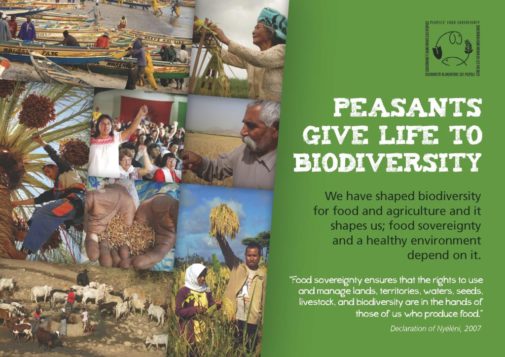 Peasants Give Life to Biodiversity
Peasants Give Life to Biodiversity
This 16 page brochure, based on a report prepared for the Agricultural Biodiversity Working Group of the IPC for Food Sovereignty, is available in Arabic, English, French, Portuguese and Spanish, at foodsovereignty.org/biodiversity
[1] IPES-Food, 2016: ‘From Uniformity to Diversity: A paradigm shift from industrial agriculture to diversified agroecological systems’
www.ipes-food.org/images/Reports/UniformityToDiversity_FullReport.pdf
[2] Down to Earth (2010). Bolivia condemns UN’s pro-market biodiversity policy, M. Suchitra, Down to Earth, 23 October 2012, //climateandcapitalism.com/2012/10/23/bolivia-condemns-uns-pro-market-policy-on-biodiversity/
[3] La Vía Campesina (2016). Statement from Bali at the Treaty’s consultation on Farmers’ Rights “Nothing about us without us”
https://viacampesina.org/en/index.php/main-issues-mainmenu-27/biodiversity-and-genetic-resources-mainmenu-37/2148-nothing-about-us-without-us-saypeasants-
as-the-farmers-rights-consultation-begins-in-bali
For further reading see:
Co-creating the agricultural biodiversity that feeds us. LEISA India. http://leisaindia.org/articles/co-creating-the-agricultural-biodiversity-that-feeds-us/
Mainstreaming problems away: Contentious Agricultural Biodiversity Decisions Drowned Out. ECO @ CBD/SBSTTA20. www.cbdalliance.info/en/wpcontent/uploads/2016/04/ECO-1-SBSTTA-20-V3-for-printing.pdf
– – – – – – – – – – –
Indigenous Peoples and Biodiversity: Traditional Knowledge, Customary Use and Indicators for the CBD’s Strategic Plan for Biodiversity 2011–2020
By Mrinalini Rai, Global Forest Coalition, Thailand
In 2011, the Convention on Biological Diversity (CBD) adopted the 2020 Aichi Biodiversity Targets. Aichi Target 18 states that by 2020, the traditional knowledge, innovations, and practices of indigenous and local communities relevant for the conservation and sustainable use of biodiversity, and their customary use of biological resources, are respected, subject to national legislation and international obligations, and fully integrated and reflected in the implementation of the Convention with the full and effective participation of indigenous and local communities, at all relevant levels.
To monitor progress towards the target, four indicators have been adopted. These are: Trends in linguistic diversity and numbers of speakers of indigenous languages (decision VII/30 and VIII/15); Trends in land-use change and land tenure in the traditional territories of indigenous and local communities (decision X/43); Trends in practice of traditional occupations (decision X/43); and Trends in the degree to which traditional knowledge and practices are respected through their full integration, safeguard, and effective participation in the national implementation of the Strategic Plan (Ad Hoc Open-ended Working Group on the Review of Implementation).
In addition, the contribution of collective action and customary sustainable use by Indigenous Peoples and local communities to biodiversity conservation is gaining recognition and is also being recognized in several other CBD decisions at Conference of the Parties (COP) 12 such as in Article 8j on traditional knowledge, and Article 10c on customary sustainable use. Indigenous Peoples and local communities can also assist in measuring and aggregating both quantitative as well as qualitative data. Community-Based Monitoring and Information Systems (CBMIS) [1] are increasingly recognized as important complementary sources of knowledge that can contribute to scientific knowledge and data analysis, as well as to decision-making, monitoring and reporting for local, national and global policy, including adequacy of the protected area systems and the role of Indigenous and Community Conserved Areas and Territories (ICCAs). [2] ICCAs—which are included as other effective area-based conservation measures in Aichi Target 11 [3] —can provide secure tenure through land and natural resource laws; decentralise and enhance rights to steward; govern and manage natural resources; and recognise traditional authorities and customary laws and practices. [4] Their value lies in the collective nature of the conservation actions.
Members of the Abolhassani tribal confederacy in Iran. Cenesta/CIC
The indicator on land use and tenure captures the relationship between traditional knowledge, customary sustainable use, and land-use change and land tenure. Changes in land use like the conversion of indigenous forests to large-scale agriculture and the encroachment of extractive industries has an impact by decreasing the opportunity of Indigenous Peoples and local communities (particularly women) to practice traditional knowledge and customary sustainable use through traditional occupations.
The CBD Parties have also referred to the importance of developing community protocols in relation to access to traditional knowledge associated with genetic resources and the fair and equitable sharing of benefits arising from the utilization of that knowledge, and as such they can contribute to both Target 18, and the objectives of the Nagoya Protocol. [5] Community protocols are built and validated collectively over a number of years with participation from men, women, youth, and elders. They are holistic and, in the access and benefit sharing process or other processes that require community consent, they will set the tone, conditions, and aspirations of Indigenous Peoples regarding research, negotiations about local resources and knowledge, and the misuse of resources and/or traditional knowledge. [6]
This also means that the knowledge transfer of community protocols over generations is crucial to governance systems and institutions, as well as in promoting customary sustainable use, and to ensure the sharing of equitable benefits from biodiversity resources with communities.
The Ad Hoc Technical Expert Group Meeting on Indicators for the Strategic Plan for Biodiversity 2011–2020 in its report (September 2015) stated the relevance of Target 18 for and applicable to all Parties to the Convention, not just those countries where there were recognized Indigenous peoples. [7] However, the official document in Section II, E, para 27, [8] notes that only a total of five countries (Bolivia, Canada, Costa Rica, Peru, and South Africa) provided information on whether they assessed the role of collective action, including by indigenous and local communities, and non-market approaches for mobilizing resources for achieving the objectives of the Convention. A total of 17 Parties indicated that no such assessment was necessary while 30 Parties had not yet started and six countries reported that some assessments were undertaken. The thirteenth conference of the parties of the CBD will hopefully follow up on the guiding principles for reporting on collective action under the resource mobilisation framework (UNEP/CBD/COP/13/11) [9] in this respect.
The upcoming CBD COP13 taking place in Cancún, Mexico from 4–17 December is gearing up for “mainstreaming biodiversity for well-being” and, as such, it is crucial for collective action of Indigenous peoples and local communities to be included and recognized as contributing to biodiversity conservation. There is a need to go beyond economic measurements and the use and recognition of traditional knowledge and collective action can assist in identifying, implementing and monitoring indicators of the well-being of peoples, biodiversity and the planet.
The countdown has begun. If not now—then when?
[1] Community-Based Monitoring and Information Systems (CBMIS) refers to the bundle of monitoring approaches used by indigenous peoples
and local communities as tools for their management and documentation of their resources. These relate to biodiversity, ecosystems, land and
water, and other resources, as well as human well-being. http://swed.bio/focal-areas/themes/biocultural-diversity/cbmis/
[2] Ad Hoc Technical Expert Group on Indicators for the Strategic Plan for Biodiversity 2011–2020,
4–17 September 2015, Geneva, Switzerland. https://www.cbd.int/doc/?meeting=ID-AHTEG-2015-01
[3] Aichi Target 11: By 2020, at least 17 per cent of terrestrial and inland water, and 10 per cent of coastal and marine areas, especially areas of
particular importance for biodiversity and ecosystem services, are conserved through effectively and equitably managed, ecologically
representative and well connected systems of protected areas and other effective area-based conservation measures, and integrated into the
wider landscapes and seascapes. https://www.cbd.int/sp/targets/
[4] See also: https://globalforestcoalition.org/wp-content/uploads/2016/09/CBD-submission-on-poverty- eradication-and- SD-final.pdf
[5] Training Workshop on Community-based Monitoring, Indicators on Traditional Knowledge and Customary Sustainable Use and Community
Protocols, within the Strategic Plan for Biodiversity 2011–2020, 8–10 June 2015 Panajachel, Guatemala.
https://www.cbd.int/doc/?meeting=A8JWS-2015-01
[6] Teran, M. Y. (2016). The Nagoya Protocol and Indigenous Peoples. The International Indigenous Policy Journal, 7(2). Retrieved from:
http://ir.lib.uwo.ca/iipj/vol7/iss2/6 on 18 October 2016.
[7] Ibid., 2.
[8] Ibid., 7.
[9] See Resource Mobilization: Analysis of the Information Provided Through the Financial Reporting Framework and of Methodological
Information and Definitions as Provided by Parties, CBD COP 13, Agenda Item 11. https://www.cbd.int/doc/?meeting=COP-13
– – – – – – – – – – –
Feature: Climate Finance: dark days for the world’s forests
By Coraina de la Plaza, Indigenous Rights Advisor and Research Assistant, Global Forest Coalition
The overall picture for forest conservation and restoration has been rather dark in recent years, and the future prospects of the world’s remaining forests look even less promising after recent international political developments. This is largely due to the fact that monoculture tree plantations, most of them based on invasive alien species such as eucalyptus and pine, are increasingly seen by many as a great opportunity to mitigate climate change, expand and restore forest cover, and generate other benefits such jobs and income. However these assumptions—even though they are included in a range of key mechanisms intended to address climate change— are deeply flawed.
One of the main justifications used by many tree plantation projects is that these projects will take place in ‘degraded and/or abandoned (agricultural) lands’, increasing forest cover and its associated functions and values, as well as reducing greenhouse gas emissions. Yet, in many countries, such as Peru for example, [1] plantations have led to further deforestation of natural forests. In addition, in many project proposals the term ‘degraded lands’ is poorly defined and/or fails to mention whether those degraded lands are supporting livelihoods. The definition of what constitutes agroforestry is also vague. [2]
There are many specific case studies that have documented how monoculture tree plantations can have multiple negative impacts including loss of natural forests and biodiversity, depletion and pollution of available water, loss of livelihoods, displacement of communities and land grabbing. They also store less carbon. [3] Examples include the Global Woods company project in the Kikonda Forest Reserve in Uganda, [4] a tree plantation carbon sink project at Idete Tanzania developed by the Norwegian company Green Resources Ltd, [5] and the expansion of a large-scale plantation at the edge of the Pry Lang forest in Cambodia run by a Korean company with the government´s permission.[6]
Nevertheless, Article 5 [7] of the Paris Agreement on climate change—which was signed in December 2015 at the end of the UNFCCC COP 21 negotiations—endorses forests, acknowledging them as a key means of meeting the 2oC or 1.5oC degrees targets. This, however, bring us back to a well-known problem: the lack of an appropriate globally accepted definition of forests.[8]

Eucalyptus plantations such as this one in South Africa are classed as forests by the FAO.
Mathias Rittgerott, Rainforest Rescue/CIC
The definition provided by the Food and Agriculture Organization (FAO) is the most commonly accepted one, but it is a perverse definition, as it includes tree plantations as a type of forest.
In addition REDD+ is also strongly promoted in the Paris Agreement, and many countries’ Nationally Determined Contributions (NDCs) also refer to their REDD+ national plans as a means of mitigating climate change (eg Mozambique [9]). Many REDD+ national plans include monoculture tree plantations. On the top of this, the Paris Agreement recognises the relevance of “adequate and predictable financial resources” for REDD+, leaving the door open to bilateral, multilateral, public or private finance.
Industry’s bid to use all available mechanisms to promote the expansion of monoculture tree plantations does not stop with the Paris Agreement of course. International climate-related financial mechanisms, and the private sector itself, also play a huge role in the expansion of these green deserts.
For instance, in April 2016, the World Bank launched its dreadful Forest Action Plan 2016-2020 (FAP 2016)—which should really be renamed the “Tree Plantation Action Plan”. This document is plagued by terms such as plantations, planted forests, tree planting, commercial reforestation, etc., and plantations are constantly promoted as opportunities for poverty alleviation, the creation of wealth, and climate change mitigation. This document even states that, “in addition, biodiversity is not only found in natural forests under protection status; it represents an essential element of production forests and trees in the landscape (including plantations)”. But, as has been repeatedly documented, the biodiversity associated with tree plantations, especially monocultures, is significantly lower than that found in natural forests.[10]
Of course, the whole World Bank plan is strongly focused on a desire to engage, partner, finance and otherwise support the private sector. For many of you, the FAP 2016 and its desire to engage the private sector will not come as a surprise. However, is important to keep in mind that the current critical situation—in terms of lack of economic resources to combat climate change and its drivers—also constitutes a massive opportunity for the private sector to increase their profits.
In fact, following on from Paris, and with the support of the World Bank, development plans that are likely to result in the proliferation of tree plantations are already underway. For instance, the African Forest Landscape Restoration Initiative (AFR100), set to be supported by the World Bank to the tune of US$1 billion, [11] proposes to restore 100 million hectares of deforested and degraded land by 2030, in support of the Bonn Challenge and the New York Declaration on Forests. While this initiative is not necessarily damaging, and does have the potential to restore natural forests, concern has already been expressed by civil society organisations because AFR100 shares features with other large-scale plans promoted by the WB and private sector which have led to the expansion of monoculture tree plantations.[12]
The ‘lack of resources’ argument has provided the perfect excuse for governments, intergovernmental institutions and the private sector itself to repeatedly highlight the need to involve the private sector more, allowing them to keep making profits—even if it is actually at the expense of nature, rather than benefiting it. The forestry sector provides the perfect example of this: if the private sector wants to expand plantations, evidence that monoculture and trees in old growth forests are fundamentally different, with respect to both climate change and biodiversity, seems to be conveniently overlooked.[13]
The private sector has profit generation as its primary goal, which means that it has a strong economic incentive to invest in commercial activities like large-scale commercial tree plantations, rather than community conservation initiatives. The latter may be socially and environmentally beneficial, but they are less profitable from a commercial perspective. The increasing tendency for climate finance mechanisms to look to the private sector (including through public-private finance partnerships) is therefore likely to have an inherent bias towards the spread of commercial tree plantations.
The World Bank’s deepening involvement in climate change processes is aggravating this problem. For example, the World Bank is the Trustee of many climate and forest related funds, including the Forest Investment Program (FIP), the Forest Carbon Partnership Facility (FCPF) and the Global Environmental Facility (GEF). It is now planning to coordinate the various forest-related funds’ sustainable development and climate change goals and interventions. To this end the FAP 2016-2020, in line with the Paris Agreement, might aim to focus even more sharply on directing already scarce money towards these false solutions and the destruction of natural forests. For example, the Jari Amapá REDD+ project in Brazil is run by three companies, including a logging and pulp company, and is based on the establishment of tree plantations consisting mostly of Eucalyptus. It will have negative impacts on the environment and the local communities living the area.[14]
This cannot continue. We need to move away from these false solutions as swiftly as we can, given the urgency with which we need to address the climate change crisis. As more funds are mobilised for climate change mitigation, is more important than ever to continue the struggle against the misuse of those funds to finance false solutions like monoculture tree plantations, which have negative consequences not only on forests and the environment, but also on vulnerable groups that rely on forests for their survival like indigenous peoples, local communities and women.
[1] https://news.mongabay.com/2016/01/mostfrontiersofplantationexpansionarelosingfarmoretreestodeforestationthanharvesting/
[2] See the comments on a project proposal presented by Mozambique´s government for a potential Forest Investment Program
project https://wwwcif.climateinvestmentfunds.org/sites/default/files/meetingdocuments/drc_response_to_us_and_uk_comments.pdf
[3] https://news.mongabay.com/2016/01/mostfrontiersofplantationexpansionarelosingfarmoretreestodeforestationthanharvesting/
[4] http://www.reddmonitor.org/2016/01/08/globalwoodsplantationsinugandatreesversusfood/
[5] http://globaljusticeecology.org/files/CDM%20plantations%20report.pdf
[6] https://www.tni.org/files/publicationdownloads/11icas_cp_scheidel_and_work.pdf
[7] https://unfccc.int/resource/docs/2015/cop21/eng/l09r01.pdf
[8] http://www.fao.org/forestry/plantedforests/67504/en/
[9] http://wrm.org.uy/wpcontent/uploads/2016/10/201610PlantationsinESAfricaTWWRMmedscreen.pdf
[10] See for instance http://link.springer.com/article/10.1007/s1053101510225 and http://www.sinkswatch.org/plants.html
[11] http://wrm.org.uy/wpcontent/uploads/2016/10/201610PlantationsinESAfricaTWWRMmedscreen.pdf
[12] See for instance a joint letter send the 21st September on the International Day Against Monoculture Tree Plantations:
http://globaljusticeecology.org/signonstopmonoculturetreeplantationsexpansioninmozambique/
[13] https://news.mongabay.com/2016/01/mostfrontiersofplantationexpansionarelosingfarmoretreestodeforestationthanharvesting/
[14] For more information about this project see http://noredd.com/thejariamapareddprojectbrazilgreenwashingillegalloggingapulpmillanda48yearoldlandgrab/
– – – – – – – – – – –
Feature: Biodiversity and poverty: steering clear of The Midas Touch*
By Simone Lovera, Global Forest Coalition, Paraguay
One of the sympathetic dimensions of the Convention on Biological Diversity (CBD) is the willingness of its Parties to discuss matters that go beyond the scope of conventional conservation approaches. One of those matters is the link between poverty eradication and biodiversity. [1]
In-depth discussions between 2010 and 2014 led to the adoption of the Chennai Guidance for the Integration of Biodiversity and Poverty Eradication (Decision XII/5) by the twelfth Conference of the Parties to the CBD in 2014.[2] The Chennai Guidance is quite remarkable and can be seen as a predecessor of the transformative change approach to economic development that was formally incorporated in Agenda 2030 and its Sustainable Development Goals (SDGs).
Parties to the CBD clearly acknowledged that many financially ‘poor’ communities have traditionally been very effective at conserving biodiversity, including through Indigenous Peoples’ and Community Conserved Territories and Areas (ICCAs) and other community conservation initiatives, and that these initiatives play a key role in sustaining their livelihoods. As such, it strongly recommends recognising ICCAs and other community conservation initiatives appropriately, and supporting them as a basis for biodiversity policies and programmes, including the Aichi Targets in the CBD’s Strategic Plan, and the SDGs.
The Chennai Guidance also recognises one of the ironic dimensions of the relationship between poverty and ICCAs, namely that ICCAs themselves make the poor rich. Many of the women and men that sustain and depend on ICCAs and other ecosystems may be classified as poor from a financial perspective, but the wealth of nature that surrounds them provides them with a wide array of resources, including food, water, fuel, construction materials and traditional medicines. However, they need to maintain access to these resources in accordance with customary laws and practices as they lack the financial resources to pay for them.
It is for precisely this reason that market-based approaches to biodiversity conservation, and the financialisation of biodiversity in general, pose such a threat to economically marginalised women and men. When their treasures, the forests and other ecosystems that were so often ignored by mainstream policy makers, are suddenly recognised as ‘natural capital’, they become financial products, which may make others rich, but prevent them from benefiting from their traditional resources.
However, because economic and political marginalisation tend to go hand in hand, those who are poor from a monetary perspective—Indigenous Peoples, women and the rural poor in general—are generally unable to defend their interests in decision-making processes that affect them, and may also find it difficult to be heard in ‘multi-stakeholder’ processes.

A young man from Hageulu, Solomon Islands, extracts the bark of
bittelnut tree for medicine. James Meimana/CIC
In fact, as shown by the first 33 community conservation resilience assessments facilitated by the global Community Conservation Resilience Initiative [3], one of the most significant trends of the 21st century is the increasing exploitation of the ‘natural capital’ of the rural poor by urban consumers and rich elites. Such exploitation includes the relentless extraction of wood from forests, and land grabbing for the production of commodities like tea, coffee, beef, tobacco, palm oil and soy feedstock, including for food, animal feed and bio-industries.
This ‘Midas Touch’ also includes seemingly more benign forms of exploitation like the establishment, expansion or redesignation of protected areas for climate mitigation. For example, it has recently been announced that the International Civil Aviation Organization (ICAO) plans to offset a significant portion of the greenhouse gas emissions of the aviation sector [4] (the most rapidly growing source of CO2 emissions on the planet) with trees and other carbon sinks. This might trigger an explosion of new forms of green land grabbing establishing carbon sinks to compensate for flights being taken by those who can afford to take long distance holidays (and pay to clear their consciences by purchasing offsets).[5]
And despite many promises by gatherings like the 2014 World Parks Congress [6] and the recent 2016 World Conservation Congress [7]—indicating that conflicts between protected areas and ICCAs should be avoided and that the rights of local communities should be respected in protected area policies—the findings of CCRI processes in countries like Nepal, Kenya and India show that conservation conflicts are, sadly, still common.[8]
The world’s ‘poor’ will be better off if their biodiversity is not recognised as ‘natural capital’. The intentions of some of those that promote the concept might be benign, but they are also being rather naive from a social science perspective, ignoring decades of research about the risks of elite resource capture.[9] That is not to say that the world’s poor do not need support. In fact, the CCRI also clearly concluded there is a need to ensure rural communities are able to make an economically sound living in a sustainable manner, through endogenous livelihood strategies like small-scale agriculture, community-based forestry and bee-keeping; and that they have access to the basic services made available to others, including health and education.
The Midas Touch, turning the world’s riches into ‘natural capital’, is not the way to go.
*In Greek mythology, the legend of King Midas tells that he wished for and was granted the power to turn all that he touched to gold. At first he was delighted, but his delight soon turned to sorrow when first his food and then his daughter were transformed into lifeless gold. He realised his wish was foolish, and prayed to the gods, who removed his power.
[1] See also https://globalforestcoalition.org/wp-content/uploads/2016/09/CBD-submission-on-poverty-eradication-and-SD-final.pdf
[2] https://www.cbd.int/decision/cop/default.shtml?id=13368
[3] https://globalforestcoalition.org/campaigns/supporting-community-conservation/
[4] http://www.icao.int/Newsroom/Pages/Historic-agreement-reached-to-mitigate-international-aviation-emissions.aspx
[5] See also http://www.fern.org/icao
[6] http://worldparkscongress.org/about/promise_of_sydney.html
[7] https://portals.iucn.org/congress/motion/029
[8] https://intercontinentalcry.org/protected-areas-threat-sustainable-development-goals/
[9] See for example Agrawal, A., 2007. Forests, Governance, and Sustainability: Common Property Theory and its Contributions. International Journal of the Commons
Vol 1, no 1 October 2007, pp. 111-136, or Chomba, S., Kariuki, J., Driis Lund, J. and Sinclair, F., 2016. Roots of inequity: How the implementation of REDD+ reinforces past injustices. Land Use Policy 50 (2016) 202–213.

